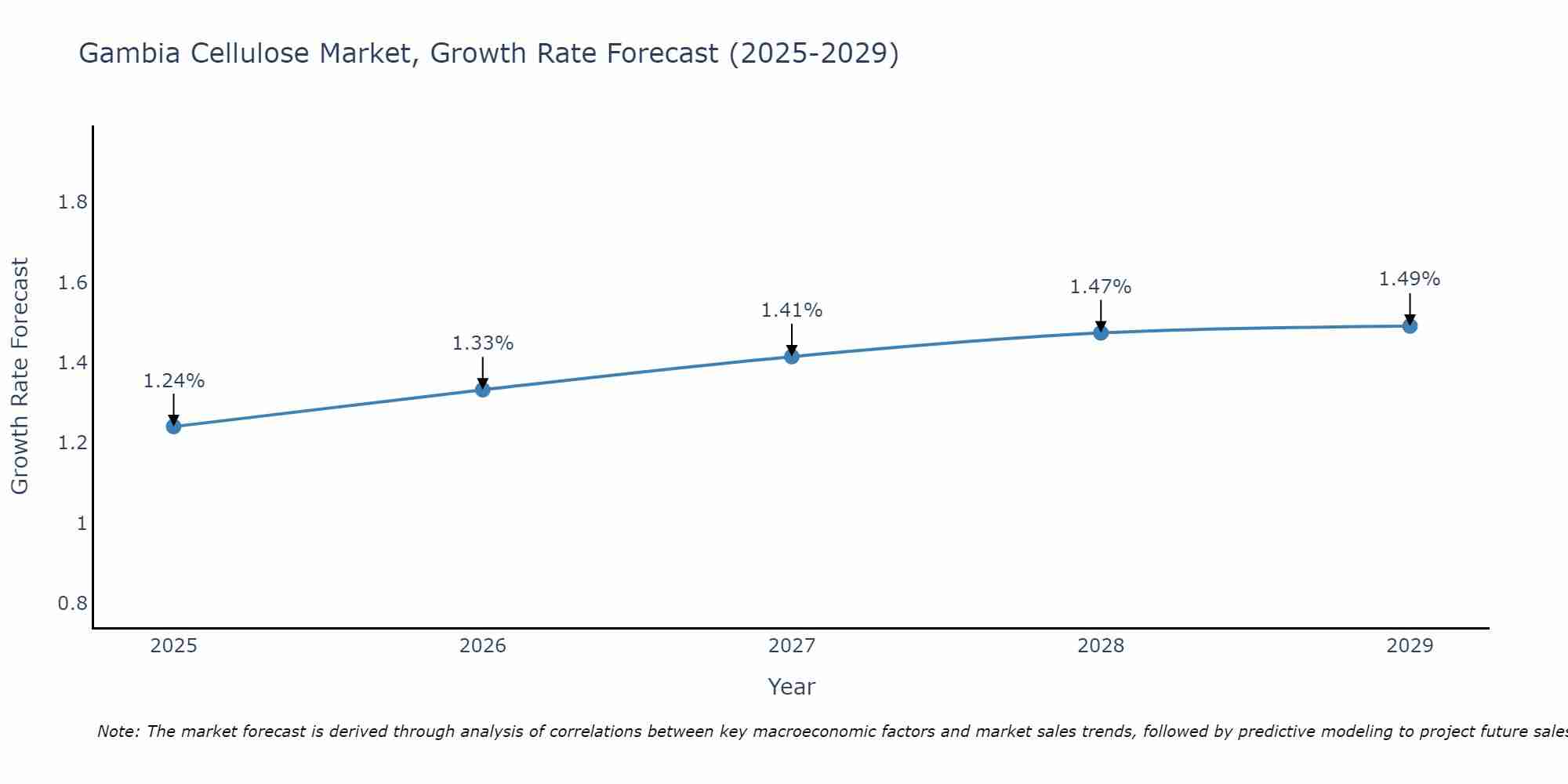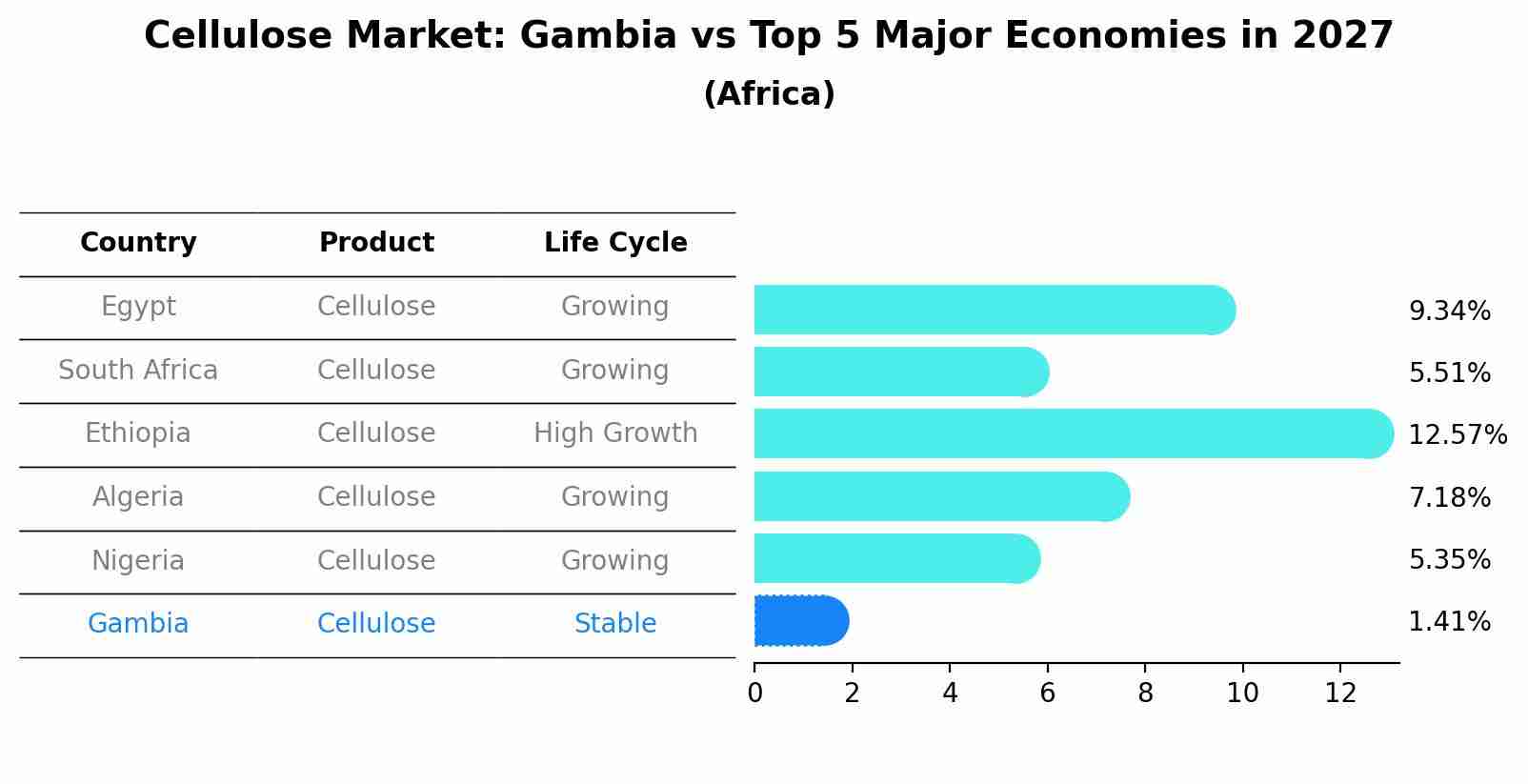Gambia Cellulose Market (2025-2031) | Industry, Outlook, Value, Growth, Companies, Share, Size, Revenue, Trends, Segmentation, Analysis & Forecast
| Product Code: ETC4661953 | Publication Date: Nov 2023 | Updated Date: Sep 2025 | Product Type: Market Research Report | |
| Publisher: 6Wresearch | Author: Shubham Deep | No. of Pages: 60 | No. of Figures: 30 | No. of Tables: 5 |
Gambia Cellulose Market Size Growth Rate
The Gambia Cellulose Market is poised for steady growth rate improvements from 2025 to 2029. From 1.24% in 2025, the growth rate steadily ascends to 1.49% in 2029.

Cellulose Market: Gambia vs Top 5 Major Economies in 2027 (Africa)
The Cellulose market in Gambia is projected to grow at a stable growth rate of 1.41% by 2027, within the Africa region led by Egypt, along with other countries like South Africa, Ethiopia, Algeria and Nigeria, collectively shaping a dynamic and evolving market environment driven by innovation and increasing adoption of emerging technologies.

Gambia Cellulose Market Overview
The cellulose market in Gambia is expanding as industries such as paper and packaging, textiles, and construction increasingly adopt cellulose-based products. Cellulose is a primary raw material for paper production, and with the rising demand for paper and packaging products, the market for cellulose is expected to grow. Additionally, the growing focus on eco-friendly materials is driving interest in cellulose-based alternatives in various industries.
Drivers of the market
The Gambia cellulose market is growing due to its versatile applications in industries such as paper, textiles, pharmaceuticals, and food. Cellulose is used in the production of paper, as a food additive, and in pharmaceuticals for drug formulations. As Gambias industrial sector expands, there is a growing demand for cellulose for use in paper products and biodegradable packaging solutions. Additionally, the rising awareness of sustainability and the move towards eco-friendly alternatives in various industries are contributing to the market`s growth.
Challenges of the market
The Cellulose Market in Gambia faces challenges related to the limited local manufacturing capacity and the reliance on imports. There is little domestic production of cellulose, which is used in industries such as paper, textiles, and pharmaceuticals. The cost of importing cellulose, coupled with shipping delays and high tariffs, makes it expensive for local businesses. Additionally, there is limited investment in infrastructure for processing cellulose locally, which restricts growth in the market.
Government Policy of the market
The cellulose market in Gambia is aligned with the global demand for renewable, eco-friendly materials. The government supports the market by encouraging sustainable forestry practices and the development of local cellulose production capacities. Policies also focus on ensuring that cellulose products, such as paper and textiles, meet international environmental and safety standards. The government`s strategy includes boosting export opportunities for locally produced cellulose while promoting domestic consumption through various industry incentives.
Key Highlights of the Report:
- Gambia Cellulose Market Outlook
- Market Size of Gambia Cellulose Market, 2024
- Forecast of Gambia Cellulose Market, 2031
- Historical Data and Forecast of Gambia Cellulose Revenues & Volume for the Period 2021-2031
- Gambia Cellulose Market Trend Evolution
- Gambia Cellulose Market Drivers and Challenges
- Gambia Cellulose Price Trends
- Gambia Cellulose Porter`s Five Forces
- Gambia Cellulose Industry Life Cycle
- Historical Data and Forecast of Gambia Cellulose Market Revenues & Volume By Fiber Type for the Period 2021-2031
- Historical Data and Forecast of Gambia Cellulose Market Revenues & Volume By Natural Cellulose Fibers for the Period 2021-2031
- Historical Data and Forecast of Gambia Cellulose Market Revenues & Volume By Man-made Cellulose Fibers for the Period 2021-2031
- Historical Data and Forecast of Gambia Cellulose Market Revenues & Volume By Applications for the Period 2021-2031
- Historical Data and Forecast of Gambia Cellulose Market Revenues & Volume By Apparel for the Period 2021-2031
- Historical Data and Forecast of Gambia Cellulose Market Revenues & Volume By Home Textile for the Period 2021-2031
- Historical Data and Forecast of Gambia Cellulose Market Revenues & Volume By Industrial for the Period 2021-2031
- Historical Data and Forecast of Gambia Cellulose Market Revenues & Volume By Others for the Period 2021-2031
- Gambia Cellulose Import Export Trade Statistics
- Market Opportunity Assessment By Fiber Type
- Market Opportunity Assessment By Applications
- Gambia Cellulose Top Companies Market Share
- Gambia Cellulose Competitive Benchmarking By Technical and Operational Parameters
- Gambia Cellulose Company Profiles
- Gambia Cellulose Key Strategic Recommendations
Frequently Asked Questions About the Market Study (FAQs):
1 Executive Summary |
2 Introduction |
2.1 Key Highlights of the Report |
2.2 Report Description |
2.3 Market Scope & Segmentation |
2.4 Research Methodology |
2.5 Assumptions |
3 Gambia Cellulose Market Overview |
3.1 Gambia Country Macro Economic Indicators |
3.2 Gambia Cellulose Market Revenues & Volume, 2021 & 2031F |
3.3 Gambia Cellulose Market - Industry Life Cycle |
3.4 Gambia Cellulose Market - Porter's Five Forces |
3.5 Gambia Cellulose Market Revenues & Volume Share, By Fiber Type, 2021 & 2031F |
3.6 Gambia Cellulose Market Revenues & Volume Share, By Applications, 2021 & 2031F |
4 Gambia Cellulose Market Dynamics |
4.1 Impact Analysis |
4.2 Market Drivers |
4.2.1 Increasing demand for sustainable and eco-friendly products |
4.2.2 Growth in the textile and apparel industry |
4.2.3 Rise in the use of cellulose-based products in pharmaceuticals and food industries |
4.3 Market Restraints |
4.3.1 Fluctuating prices of raw materials |
4.3.2 Stringent regulations on deforestation and environmental conservation |
4.3.3 Competition from synthetic alternatives |
5 Gambia Cellulose Market Trends |
6 Gambia Cellulose Market Segmentations |
6.1 Gambia Cellulose Market, By Fiber Type |
6.1.1 Overview and Analysis |
6.1.2 Gambia Cellulose Market Revenues & Volume, By Natural Cellulose Fibers, 2021-2031F |
6.1.3 Gambia Cellulose Market Revenues & Volume, By Man-made Cellulose Fibers, 2021-2031F |
6.2 Gambia Cellulose Market, By Applications |
6.2.1 Overview and Analysis |
6.2.2 Gambia Cellulose Market Revenues & Volume, By Apparel, 2021-2031F |
6.2.3 Gambia Cellulose Market Revenues & Volume, By Home Textile, 2021-2031F |
6.2.4 Gambia Cellulose Market Revenues & Volume, By Industrial, 2021-2031F |
6.2.5 Gambia Cellulose Market Revenues & Volume, By Others, 2021-2031F |
7 Gambia Cellulose Market Import-Export Trade Statistics |
7.1 Gambia Cellulose Market Export to Major Countries |
7.2 Gambia Cellulose Market Imports from Major Countries |
8 Gambia Cellulose Market Key Performance Indicators |
8.1 Percentage of cellulose-based products in the overall market |
8.2 Adoption rate of sustainable practices in cellulose production |
8.3 Research and development investment in cellulose technology |
9 Gambia Cellulose Market - Opportunity Assessment |
9.1 Gambia Cellulose Market Opportunity Assessment, By Fiber Type, 2021 & 2031F |
9.2 Gambia Cellulose Market Opportunity Assessment, By Applications, 2021 & 2031F |
10 Gambia Cellulose Market - Competitive Landscape |
10.1 Gambia Cellulose Market Revenue Share, By Companies, 2024 |
10.2 Gambia Cellulose Market Competitive Benchmarking, By Operating and Technical Parameters |
11 Company Profiles |
12 Recommendations | 13 Disclaimer |
- Single User License$ 1,995
- Department License$ 2,400
- Site License$ 3,120
- Global License$ 3,795
Search
Related Reports
- Vietnam System Integrator Market (2025-2031) | Size, Companies, Analysis, Industry, Value, Forecast, Growth, Trends, Revenue & Share
- ASEAN and Thailand Brain Health Supplements Market (2025-2031) | Strategy, Consumer Insights, Analysis, Investment Trends, Opportunities, Growth, Size, Share, Industry, Revenue, Segments, Value, Segmentation, Supply, Forecast, Restraints, Outlook, Competition, Drivers, Trends, Demand, Pricing Analysis, Competitive, Strategic Insights, Companies, Challenges
- ASEAN Bearings Market (2025-2031) | Strategy, Consumer Insights, Analysis, Investment Trends, Opportunities, Growth, Size, Share, Industry, Revenue, Segments, Value, Segmentation, Supply, Forecast, Restraints, Outlook, Competition, Drivers, Trends, Demand, Pricing Analysis, Competitive, Strategic Insights, Companies, Challenges
- Europe Flooring Market (2025-2031) | Outlook, Share, Industry, Trends, Forecast, Companies, Revenue, Size, Analysis, Growth & Value
- Saudi Arabia Manlift Market (2025-2031) | Outlook, Size, Growth, Trends, Companies, Industry, Revenue, Value, Share, Forecast & Analysis
- Uganda Excavator, Crane, and Wheel Loaders Market (2025-2031) | Strategy, Consumer Insights, Analysis, Investment Trends, Opportunities, Growth, Size, Share, Industry, Revenue, Segments, Value, Segmentation, Supply, Forecast, Restraints, Outlook, Competition, Drivers, Trends, Demand, Pricing Analysis, Competitive, Strategic Insights, Companies, Challenges
- Rwanda Excavator, Crane, and Wheel Loaders Market (2025-2031) | Strategy, Consumer Insights, Analysis, Investment Trends, Opportunities, Growth, Size, Share, Industry, Revenue, Segments, Value, Segmentation, Supply, Forecast, Restraints, Outlook, Competition, Drivers, Trends, Demand, Pricing Analysis, Competitive, Strategic Insights, Companies, Challenges
- Kenya Excavator, Crane, and Wheel Loaders Market (2025-2031) | Strategy, Consumer Insights, Analysis, Investment Trends, Opportunities, Growth, Size, Share, Industry, Revenue, Segments, Value, Segmentation, Supply, Forecast, Restraints, Outlook, Competition, Drivers, Trends, Demand, Pricing Analysis, Competitive, Strategic Insights, Companies, Challenges
- Angola Excavator, Crane, and Wheel Loaders Market (2025-2031) | Strategy, Consumer Insights, Analysis, Investment Trends, Opportunities, Growth, Size, Share, Industry, Revenue, Segments, Value, Segmentation, Supply, Forecast, Restraints, Outlook, Competition, Drivers, Trends, Demand, Pricing Analysis, Competitive, Strategic Insights, Companies, Challenges
- Israel Intelligent Transport System Market (2025-2031) | Strategy, Consumer Insights, Analysis, Investment Trends, Opportunities, Growth, Size, Share, Industry, Revenue, Segments, Value, Segmentation, Supply, Forecast, Restraints, Outlook, Competition, Drivers, Trends, Demand, Pricing Analysis, Competitive, Strategic Insights, Companies, Challenges
Industry Events and Analyst Meet
Our Clients
Whitepaper
- Middle East & Africa Commercial Security Market Click here to view more.
- Middle East & Africa Fire Safety Systems & Equipment Market Click here to view more.
- GCC Drone Market Click here to view more.
- Middle East Lighting Fixture Market Click here to view more.
- GCC Physical & Perimeter Security Market Click here to view more.
6WResearch In News
- Doha a strategic location for EV manufacturing hub: IPA Qatar
- Demand for luxury TVs surging in the GCC, says Samsung
- Empowering Growth: The Thriving Journey of Bangladesh’s Cable Industry
- Demand for luxury TVs surging in the GCC, says Samsung
- Video call with a traditional healer? Once unthinkable, it’s now common in South Africa
- Intelligent Buildings To Smooth GCC’s Path To Net Zero













